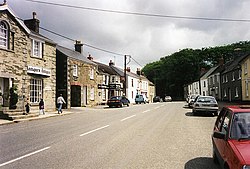Tregony
| Tregony | |
| Cornwall | |
|---|---|
 Main street in Tregony | |
| Location | |
| Grid reference: | SW925449 |
| Location: | 50°16’3"N, 4°54’45"W |
| Data | |
| Postcode: | TR2 |
| Local Government | |
| Council: | Cornwall |
Tregony sometimes in the past rendered Tregoney, is a village in Cornwall, on the east bank of the River Fal, which is here a little river.
In the village there is a post office (now closed and located in the shop), a shop, and two churches.
The names of places hereabouts can be complicated: the village is called Tregony, but the parish is Cuby. Cornelly parish was united with Tregony in 1934.
It has recently been stated that Tregony was once a port, but its entrance was blocked by a sand bar.[1] The Fal does not appear navigable by any stretch of the imagination at Tregorny today, and it is tidal only to the first bridge, at Ruan Lanihorne.
History
The manor of Tregony was recorded in the Domesday Book (1086) when it was held by Frawin from Robert, Count of Mortain. Its earliest known spelling was Trefhrigoni, in 1049.[2]There was 1 hide of land and land for 5 ploughs. There were 2 ploughs, 5 serfs, 3 villeins, 6 smallholders, 12 acres of woodland, 100 acres of pasture, 3 cattle, 40 sheep and 20 goats. The value of the manor was 15 shillings though it had formerly been worth 25 shillings.[3]
Tregony used to be considered a town and had a borough charter. Tregony therefore had the right to elect two members to the House of Commons, until the Reform Act 1832 abolished its representation, along with those of the many rotten boroughs of Cornwall: before the reform Cornwall sent more members to the Commons than the whole of Scotland. The parishes of Tregony and Cuby were united at the same time as the reform took place.
Churches and schools
The Church of St James at Tregony was founded in the 11th century but in the early 16th century it was abandoned as it had been submerged by the tidal river. (This was caused by the building of Tregony Bridge ca. 1300 which led to the accumulation of alluvial deposits on the riverbed.) The church valuables were removed to Cuby Church at some time between 1530 and 1553: for many years thereafter the building was quarried for stone and no remains were to be seen by the early 20th century. The church had been founded by the Norman family of Pomeroy whose castle stood here: nearby there were also in mediæval times a priory and a chapel of St Anne. There are no remains of any of these buildings either.[4] Since the parish lost its church, the parishioners have used Cuby Church instead, though since then Cuby, up the hill from the riverside, has been subsumed within Tregony.
The other active church in Tregony is one of the few remaining independent Congregational churches—those that did not become part of the United Reformed Church. The former Methodist[5] Church still has a small wooden sign on it but is now a private home.
There are almshouses in the village, built in 1696 and rebuilt in 1895.
Cornelly church

The parish of Cornelly near Tregony has a church but no village: it is now grouped with Tregony and Cuby. Cornelly church is dedicated to St Cornelius and was built in the 13th century: the upper part of the tower, the south porch and the windows of the south wall are 15th century additions. The font is probably 16th century but of very crudely carved granite; the pulpit is painted with coats of arms; a monument to Jane Reeves, 1783, has an excellent portrait bust of her.[6]
Outside links
| ("Wikimedia Commons" has material about Cuby) |
- "Cornwall Record Office Online Catalogue for Tregony". http://crocat.cornwall.gov.uk/dserve/dserve.exe?dsqIni=Dserve.ini&dsqApp=Archive&dsqDb=Catalog&dsqCmd=Overview.tcl&dsqSearch=((text)='tregony').
- Information on Tregony from GENUKI
References
- ↑ name=Kitridge, Alan, Cornwall's Maritime
- ↑ name=Padel, O. J., Cornish Place-Names.
- ↑ Thorn, C. et al., ed. (1979) Cornwall. Chichester: Phillimore; entry 5,24,21
- ↑ Cornish Church Guide (1925) Truro: Blackford; pp. 206-207
- ↑ "Tregony Methodist Church". http://freepages.genealogy.rootsweb.ancestry.com/~cornwallpics/tregony/pages/Methodist%20Church.htm. Retrieved 2009-04-19.
- ↑ Pevsner, N. (1970) Cornwall, 2nd ed. Penguin Books; p. 56
